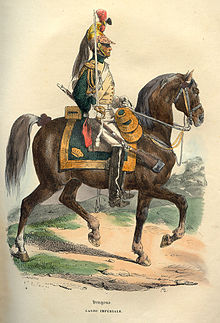Dragons de la Garde Impériale
| Dragons de la Garde Impériale | |
|---|---|

Empress' Dragoon by Hippolyte Bellangé
|
|
| Active | 1806–15 |
| Country |
|
| Allegiance | First French Empire |
| Branch | Imperial Guard |
| Type | Heavy cavalry |
| Role | Shock Action |
| Size | one regiment (1032 men, at full strength) |
| Nickname(s) | Empress' Dragoons (Dragons de l'Impératrice) |
| Engagements | Friedland, Wagram, Leipzig, Hanau, Montmirail, Waterloo |
| Commanders | |
| Notable commanders |
Jean-Thomas Arrighi de Casanova Raymond-Gaspard de Bonardi de Saint-Sulpice Philippe Antoine d'Ornano Louis-Michel Letort de Lorville Laurent Hoffmayer |
The Dragons de la Garde impériale (Dragoons of the Imperial Guard) was a heavy cavalry unit formed by Napoleon I through the decree of April 15, 1806. The "dragoon" regiments of the line had distinguished themselves in the German Campaign of 1805, and therefore Napoleon decided to reorganize the cavalry of the Guard and create within it a regiment of dragoon guards. This regiment was colloquially known as the Dragons de l'Impératrice (Empress' Dragoons), in honor of Empress Joséphine. Following the Bourbon Restoration, they were renamed Corps royal des Dragons de France (Dragoons of France Royal Corps) but were disbanded shortly afterwards. The Empress' Dragoons were reformed during the Second Empire (1852-1870).
The regiment was made up of three squadrons, headed by 60 officers personally selected by Napoleon. The first squadron was to have 296 men, and be made up of "vélites", while the other two were regular squadrons of 476 horsemen. To complete this new unit, each of the 30 dragoon regiments of the line provided 12 men, each with 10 years of service; the brigadier, chasseur, and dragoon line regiments provided the sous-officiers.
The unit's numbers rose to 1269 in 1807 with the addition of two new squadrons, and on December 9, 1813, it was attached to the Guard's 3rd regiment of éclaireurs.
The Dragons de la Garde Imperiale distinguished themselves at the battle of Friedland (1807), and at the battle of Wagram (1809). They suffered heavy losses at the battle of Maloyaroslavets and at the battle of Berezina (1812). They participated in the battles of Leipzig and Hanau (1813) and captured 18 guns at the battle of Saint-Dizier (1814). Their last battle was Marshal Ney's charge at Waterloo (1815).
...
Wikipedia
